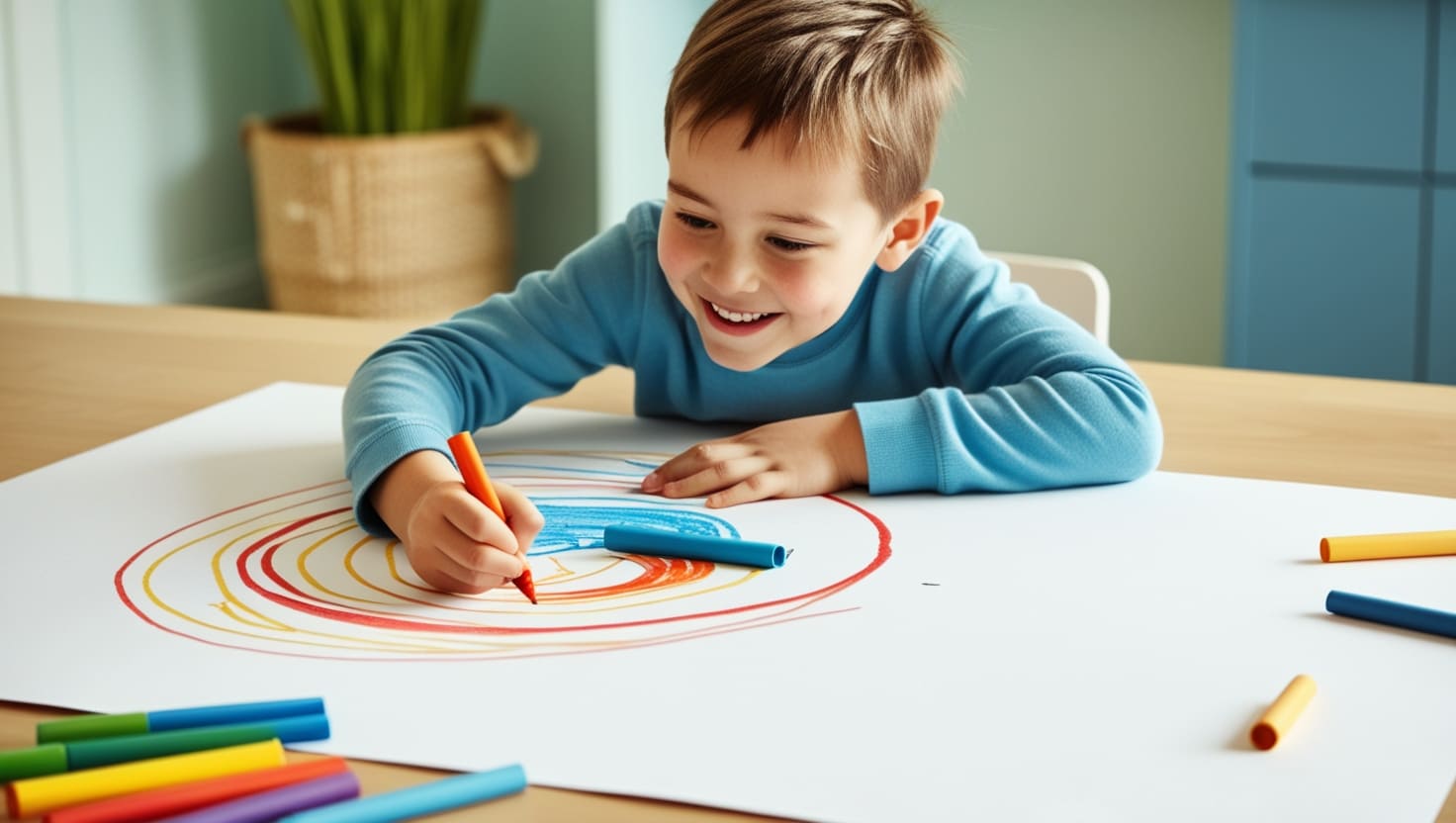المدونة
كيفية تعليم طفلك استخدام الرسم كأداة تعبيرية

غالبًا ما يُنظر إلى الرسم على أنه مجرد نشاط ترفيهي، ولكنه أكثر من ذلك بكثير. إنه أداة فعّالة للتعبير عن الذات والإبداع والتطور العاطفي. إن تشجيع طفلك على استخدام الرسم كوسيلة للتعبير عن مشاعره وأفكاره وتجاربه يُسهم بشكل كبير في رفاهيته العاطفية وتطوره المعرفي. من خلال الرسم، لا يقتصر الأمر على تعرّف الأطفال على العالم من حولهم فحسب، بل يُمكّنهم أيضًا من فهم أفكارهم ومشاعرهم الداخلية بشكل أفضل. في هذه المقالة، سنستكشف كيف يُمكنك توجيه طفلك لاستخدام الرسم كشكل من أشكال التعبير مع تشجيع إبداعه وخياله في الوقت نفسه.
١. خلق بيئة مريحة ومنفتحة للرسم
الخطوة الأولى لمساعدة طفلك على استخدام الرسم كأداة للتعبير عن نفسه هي تهيئة بيئة مريحة ومرحبة يشعر فيها بحرية استكشاف إبداعه. مساحة مفتوحة وخالية من الضغوط تتيح للأطفال التفاعل مع الفن دون خوف من الحكم أو الفشل.
- وفر مجموعة متنوعة من المواد: إن توفير مجموعة متنوعة من أدوات الرسم، مثل أقلام التلوين، وأقلام التحديد، وأقلام الرصاص الملونة، وأقلام الباستيل، وحتى الألوان المائية، يمنح طفلك حرية تجربة مختلف الوسائط. إن السماح له باستكشاف أدوات مختلفة يساعده على اكتشاف الأدوات التي يستمتع بها أكثر والتي تناسب تعبيره الإبداعي على النحو الأمثل. يمكن لتنوع المواد أن يثير أفكارًا جديدة ويلهم أعماله الفنية، مما يسمح له بتجربة متعة الإبداع دون قيود. على سبيل المثال، قد تلهم مجموعة من ألوان الألوان المائية طفلك لاستكشاف تقنيات مزج الألوان، بينما قد توفر أقلام الرصاص الملونة طريقة لرسم رسومات مفصلة ومعقدة.
- خصص ركنًا للرسم: خصص ركنًا محددًا في منزلك حيث يمكن لطفلك الجلوس والرسم كلما شعر بالإلهام. يمكن أن يكون هذا ركنًا صغيرًا في غرفته أو ركنًا مريحًا في غرفة المعيشة. يجب أن تكون هذه المساحة مجهزة بجميع أدوات الرسم التي يحتاجها - ورق الرسم، وأقلام الرصاص، والممحاة - بالإضافة إلى أي إضافات مثل اللمعان، والملصقات، أو الاستنسل. إن تخصيص مساحة للرسم يشجع طفلك على الشعور بتقدير أعماله الفنية، ويشجعه على قضاء المزيد من الوقت في التعبير عن نفسه. عندما يكون لدى الأطفال مساحتهم الخاصة، يمكنهم الانغماس في إبداعهم دون أي تشتيت.
- منطقة خالية من الأحكام: من أهم جوانب تعزيز حب الرسم خلق جو خالٍ من الأحكام. في كثير من الأحيان، قد يُثبط عزيمة الأطفال عن مواصلة نشاط ما إذا شعروا أن عملهم ليس "مثاليًا". بصفتك أحد الوالدين أو الوصي، من المهم الثناء على جهد طفلك بدلاً من التركيز فقط على النتيجة. علّق على مدى إبداع الرسم أو مدى إتقانه استخدام الألوان، بدلاً من إبداء أي تعليقات حول الجوانب التقنية. هذا يساعد الأطفال على بناء صورة إيجابية عن أنفسهم، ويتعلمون أن قيمة فنهم تكمن في العملية نفسها، وليس بالضرورة في المنتج النهائي.
٢. تشجيع التعبير العاطفي من خلال الرسم
يمكن للرسم أن يكون منفذًا لمشاعر طفلك، التي قد يجد صعوبة في التعبير عنها بالكلمات. تشجيعه على الرسم للتعبير عن مشاعره يساعده على إدراكها والتعبير عنها بطريقة صحية.
- اطرح أسئلة مفتوحة: شارك طفلك في حوارات حول مشاعره وعواطفه. اطرح أسئلة مفتوحة مثل: "كيف تشعر اليوم؟" أو "ما اللون الذي تعتقد أنه يمثل سعادتك؟". هذه الأسئلة تحفز طفلك على التفكير في مشاعره بطريقة جديدة والتعبير عنها من خلال الفن. تشجيعه على تصور مشاعر مثل الغضب والحزن والفرح في رسوماته يساعده على ربط مشاعره بالألوان والأشكال. على سبيل المثال، قد يختار رسم خطوط غاضبة ومتعرجة بألوان داكنة للتعبير عن الإحباط، أو رسم نمط زاهٍ ومتموج للتعبير عن الحماس.
- استخدم الألوان للتعبير عن المشاعر: للألوان علاقة نفسية بالمشاعر، وتعليم طفلك هذا الأمر سيساعده على استخدام الألوان في أعماله الفنية للتعبير عن مشاعره. على سبيل المثال، قد يرمز اللون الأحمر إلى الغضب أو الإحباط، بينما يمثل اللون الأزرق الحزن أو الهدوء. قد يمثل اللون الأصفر السعادة، وقد يرمز اللون الأخضر إلى النمو أو السلام. من خلال ربط الألوان بالعواطف، يمكن للأطفال استكشاف مشاعرهم بطريقة أعمق وأكثر معنى. شجعوهم على تجربة ألوان مختلفة لمعرفة أي منها يتوافق مع حالتهم المزاجية، مما يسمح لهم بتنمية ذكائهم العاطفي من خلال الفن.
- استكشاف مواضيع مختلفة: يمكنك تشجيع طفلك على الرسم عن مواقف وتجارب حياتية متنوعة، سواء كانت إيجابية أو صعبة. على سبيل المثال، قد يرسم طفلك صورة لرحلة عائلية أسعدته، أو قد يختار تصوير لحظة صعبة، مثل الشعور بالخوف أثناء عاصفة. إن السماح له باستكشاف المشاعر المختلفة والتأمل فيها من خلال الرسم يساعده على تطوير مفرداته للتعبير عن مشاعر معقدة. كما يساعده على إدراك أنه من المقبول الشعور بجميع أنواع المشاعر، وأن التعبير عنها من خلال الفن يمكن أن يكون تجربة تنفيسية.
٣. استكشاف أساليب وتقنيات الرسم المختلفة
إن تشجيع طفلك على تجربة أساليب وتقنيات مختلفة يُساعده على تطوير صوته الفني الفريد وقدراته الإبداعية. فالرسم لا يقتصر على تصوير الأشياء بدقة، بل يتعلق أيضًا بكيفية اختياره للتعبير عن نفسه من خلال هذه الوسيلة.
- الرسم الحر مقابل الرسم المنظم: امنح طفلك فرصة المشاركة في الرسم الحر والرسم المنظم. يتيح الرسم الحر له التعبير عن أفكاره وآرائه دون قيود، مما ينتج عنه غالبًا أعمال فنية مبدعة وعفوية. من ناحية أخرى، يتضمن الرسم المنظم توجيهه لرسم أشياء محددة، مثل الحيوانات أو الأشخاص أو المناظر الطبيعية. يساعد الرسم المنظم على تطوير المهارات الحركية الدقيقة والاهتمام بالتفاصيل، بالإضافة إلى فهم النسب والمنظور. كلا النهجين قيّمان بنفس القدر، إذ يُعلّمان جوانب مختلفة من فن الرسم.
- جرّب الرسم التجريدي: يُمكن أن يكون الرسم التجريدي وسيلةً مُثيرةً لطفلك لاستكشاف إبداعه بعيدًا عن قيود التمثيلات الواقعية. بدلًا من محاولة تصوير شيء مُحدد، شجّع طفلك على ابتكار أشكال تجريدية - ألوان مُتناثرة، أو أشكال هندسية، أو تجربة الخطوط والقوام. يُتيح الرسم التجريدي للأطفال التعبير عن مشاعرهم وأفكارهم التي قد لا تُجسّد بسهولة من خلال الفن التصويري. كما يُعلّمهم التفكير الإبداعي والخروج عن المألوف، مما يُساعدهم على إطلاق العنان لخيالهم ومشاعرهم الداخلية.
- دمج الوسائط المتعددة: اسمح لطفلك بدمج مواد وتقنيات مختلفة في أعماله الفنية. على سبيل المثال، يمكنه الرسم بأقلام التحديد ثم إضافة ملمس مميز بلصق القماش أو كرات القطن أو اللمعان على رسوماته. مزج الوسائط المتعددة يفتح آفاقًا إبداعية واسعة، ويشجع طفلك على التجربة واكتشاف كيفية تفاعل المواد المختلفة مع بعضها البعض. هذا الاستكشاف يُعزز مهاراته الفنية ويشجعه على التفكير الإبداعي عند إبداع أعماله الفنية.
٤. استخدام الرسم لسرد قصة
الرسم ليس مجرد رسم صورة جميلة، بل هو أيضًا وسيلة لسرد قصة. بتشجيع طفلك على استخدام الرسم كأداة لسرد القصص، تساعده على تطوير مهاراته السردية وتعلم كيفية بناء الأفكار والأحداث.
- ارسم لوحة قصصية: يُعدّ رسم لوحة القصص وسيلة رائعة للأطفال لفهم كيفية سرد القصص. شجع طفلك على رسم سلسلة من الصور التي تروي قصة قصيرة. قد تكون هذه الصور جزءًا من يومه، أو ذكرى مفضلة، أو حتى مغامرة خيالية. من خلال رسم لوحة القصص، يتعلم الأطفال التسلسل، والسبب والنتيجة، وكيفية تنظيم أفكارهم بصريًا. تساعدهم هذه العملية على بناء مهارات السرد، وهي مفيدة لسرد القصص كتابيًا وشفهيًا.
- ارسم شخصيات: ساعد طفلك على ابتكار شخصيات لقصصه. سواءً أكانت بطلاً خارقاً، أو حيواناً، أو شخصية من كتابه المفضل، فإن وجود شخصيات يتيح لطفلك تخيل أفعاله ومشاعره وتجاربه. اطلب من طفلك رسم شخصيته في مواقف مختلفة، كالفرح، والحزن، والخوف، والحماس. هذا يساعده على استكشاف مختلف الحالات العاطفية وتعلم كيفية التعبير عنها من خلال أعماله الفنية.
- اجمع الكلمات والصور: يُعدّ الجمع بين الكلمات والصور وسيلة فعّالة لتشجيع سرد القصص. اطلب من طفلك كتابة بعض الكلمات أو الجمل التي تصف رسمه، أو ساعده على تسمية عمله الفني بعنوان قصير. يُعزز هذا الجمع بين الكلمات والصور تطوره اللغوي ويدعم قدرته على إيصال الأفكار لفظيًا وبصريًا.
٥. عرض فنهم والاحتفاء به
إن عرض الأعمال الفنية لطفلك في المنزل يرسل رسالة قوية مفادها أن إبداعه موضع تقدير ويشجعه على مواصلة استكشاف مواهبه الفنية.
- أنشئ معرضًا فنيًا في منزلك: خصص جدارًا أو مساحة في منزلك لعرض أعمال طفلك الفنية. حرّك الرسومات بانتظام لإبراز أهمية أعماله. هذا لا يعزز ثقته بنفسه فحسب، بل يعزز أيضًا فكرة أن الفن يستحق الاحتفاء به. رؤية أعماله الفنية معروضة تُلهمه لمواصلة الإبداع وتوسيع آفاقه الفنية.
- امدح جهودهم وإبداعهم: ركّز دائمًا على الثناء على الجهد الذي يبذله طفلك في عمله الفني، وليس فقط على النتيجة النهائية. أثنِ على استخدامه للألوان وإبداعه وخياله. فالتعزيز الإيجابي يُعزز ثقته بنفسه ويُشجعه على المُخاطرة والتجريب في مشاريع فنية مُستقبلية.
- تقديم الأعمال الفنية كهدايا: ساعد طفلك على مشاركة أعماله الفنية مع الآخرين. يمكن أن يكون تقديم الرسومات كهدايا لأفراد العائلة أو الأصدقاء طريقة مفيدة لطفلك لمشاركة مشاعره وإبداعه. كما أنه يعلم قيمة الكرم ومتعة العطاء.
الرسم وسيلة رائعة للأطفال للتعبير عن مشاعرهم وأفكارهم وإبداعهم. بتوفير الأدوات المناسبة، وتهيئة بيئة خالية من الأحكام، وتشجيع التعبير العاطفي من خلال الفن، يُمكنك مساعدة طفلك على تطوير مهاراته العاطفية والإدراكية الأساسية. إن السماح لطفلك بتجربة أساليب وتقنيات مختلفة لا يُعزز إبداعه فحسب، بل يُعزز ثقته بنفسه أيضًا. مع الثناء والدعم المُستمر، يُمكن أن يُصبح الرسم أداةً دائمةً للتعبير عن الذات والنمو العاطفي.










